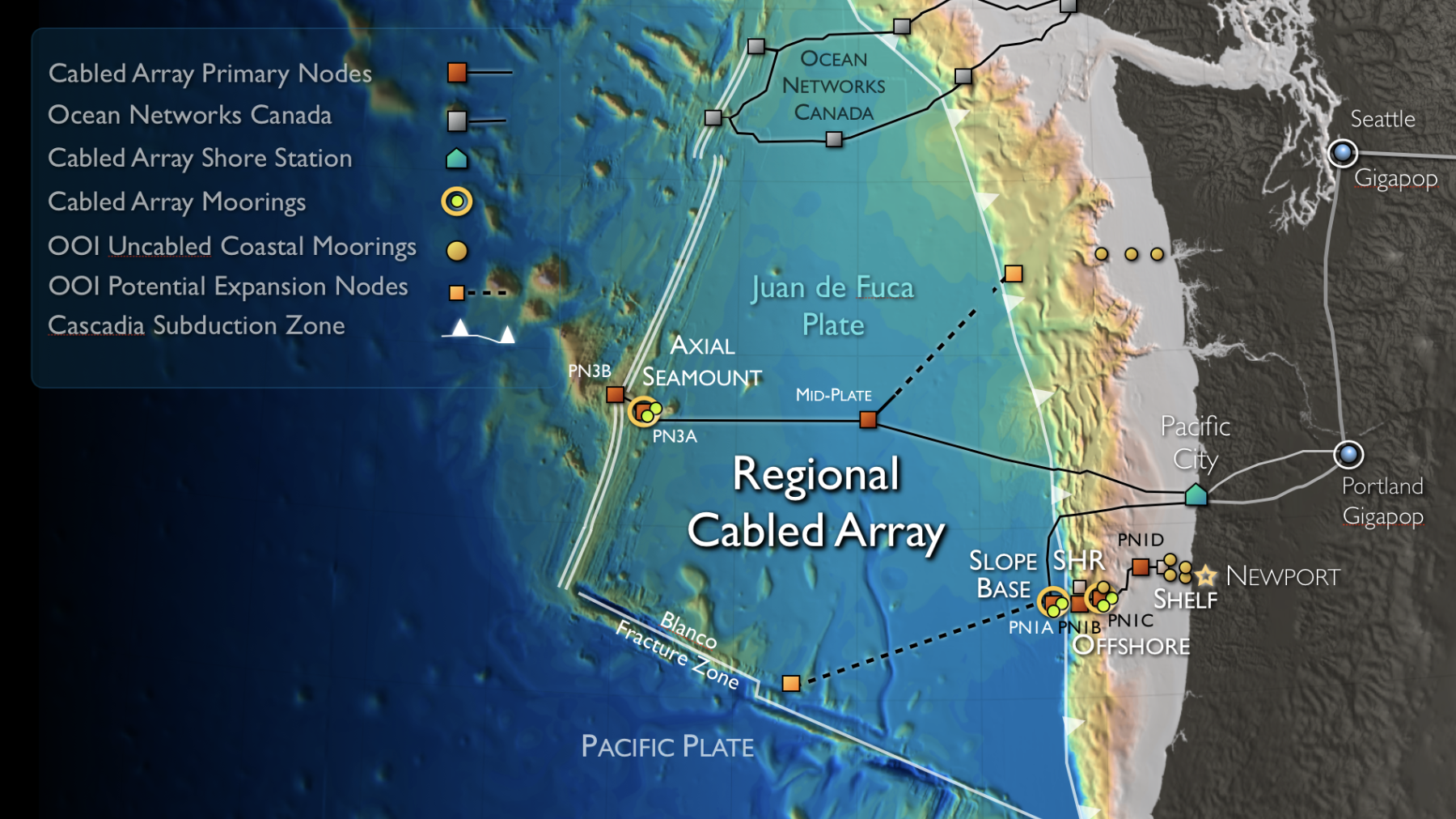-
Notifications
You must be signed in to change notification settings - Fork 12
Home
Welcome to the orcanode wiki, a subset of the top-level Orcasound organizational wiki.
Here we provide some bioacoustic context for the open source code in this repository built by the Orcasound community, as well as technical details to support the use of our free code for passive acoustic monitoring and the deployment of low-cost hydrophones to accelerate marine conservation. For details about the ongoing development of the code and to contribute, please see the README and Issues.
The orcanode code was first written in 2018 to generate a live audio stream for monitoring the critical habitat of the Southern Resident Killer Whales (SRKWs) within the inland waters of Washington (USA) at three locations. Short-term goals for this repo include: using free open source tools like ffmpeg as much as possible; providing data in formats like HLS and DASH that optimize playback on any combination of operating system, device, and browser in the Orcasound web app (production site | orcasite source code); and, utilizing low-cost cloud-based storage and operations to make reuse of our free open source code more economical.
A longer-term goal is to increase our collective listening capabilities throughout the range of the SRKWs, from Monterey Bay in California (USA) to Haida Gwaii in British Columbia (Canada) at the border with Southeast Alaska. Luckily, there is a growing suite of hydrophones (underwater microphones) deployed in this part of the northeast Pacific ocean that are capable of streaming data live or in near real time. We maintain a shared Google map of live hydrophones in the NE Pacific, especially across the SRKW range, as well as links to potential live or near real time data sources.

- SRKW monitoring by Orcasound (inland WA)
- Google map of extant/planned Orcasound hydrophone network nodes; 2022 Q4 screenshot:
 * Three 2022 production nodes: Orcasound Lab (Haro Strait), Port Townsend, Bush Point (Whidbey Island)
* Three 2022 development nodes: Point Robinson (Vashon Island), Sunset Bay (between Edmonds and Mukilteo, WA), and north San Juan Channel
* [Live streaming web app](https://live.orcasound.net/)
* [Data access via AWS CLI](https://github.com/orcasound/orcadata/blob/master/access.md)
* [AWS Open Data Registry](https://registry.opendata.aws/orcasound/)
* [Data access to live-streaming S3 bucket via Quilt.com](https://open.quiltdata.com/b/streaming-orcasound-net)
* Three 2022 production nodes: Orcasound Lab (Haro Strait), Port Townsend, Bush Point (Whidbey Island)
* Three 2022 development nodes: Point Robinson (Vashon Island), Sunset Bay (between Edmonds and Mukilteo, WA), and north San Juan Channel
* [Live streaming web app](https://live.orcasound.net/)
* [Data access via AWS CLI](https://github.com/orcasound/orcadata/blob/master/access.md)
* [AWS Open Data Registry](https://registry.opendata.aws/orcasound/)
* [Data access to live-streaming S3 bucket via Quilt.com](https://open.quiltdata.com/b/streaming-orcasound-net)
- SRKW monitoring (outer coast, US)
- Oregon coast OOI/RSN nodes
- Eventually we should build a separate page for all OOI/RSN hydrophones of interest, but for now:
- Karan's 2022 GSoC project for Orcasound: increase access to OOI hydrophones
- OOI Regional Cabled Array map:
- Oregon coast OOI/RSN nodes
 * California coast
* MARS mooring in Monterey Bay, CA (John Ryan)
* Live audio: [MBARI Soundscape Listening Room](https://www.mbari.org/soundscape-listening-room/) (mp3 stream via ??)
* Archived audio: [AWS Open Data Registry](https://registry.opendata.aws/pacific-sound/) (AWS sponsored open data registry; near real time, latency of ~1 day)
* [Orcasound Trello card with background, links](https://trello.com/c/5KbiUMXe)
* California coast
* MARS mooring in Monterey Bay, CA (John Ryan)
* Live audio: [MBARI Soundscape Listening Room](https://www.mbari.org/soundscape-listening-room/) (mp3 stream via ??)
* Archived audio: [AWS Open Data Registry](https://registry.opendata.aws/pacific-sound/) (AWS sponsored open data registry; near real time, latency of ~1 day)
* [Orcasound Trello card with background, links](https://trello.com/c/5KbiUMXe)
In addition to distilled links and resources below, see this Orcasound blog post with shortcuts to 24/7 cabled hydrophone deployments in BC, Canada.
- SRKW monitoring (inland waters and outer coast, BC)
-
BC Hydrophone Network
- CetaceaLab (Northern BC)
- Bella Bella (Central BC)
-
OrcaLab (Johnstone Strait, north end of Vancouver Island)
- Live listening community room
- Raw audio feed (RealPlayer-based?)
- SIMRES (2 hydrophones in Boundary Pass, deployed from east Saturna Island)
- MP3 live stream (SIMRES web site embed | raw stream URL)
- Trello card documenting system
- First Nations
-
BC Hydrophone Network

* Sciences, Leadership Council,
- Ocean Networks Canada (ONC) nodes (Strait of Georgia and off SW coast of Vancouver Island)
- As of 2023: 3-hour delay for public per DFO request
- ONC data portal (version 3.0 in 2022)
- Ocean Networks Canada API
- ONC hydrophone data search UI
- DFO deployments?
- John Ford's place north of Nanaimo?
- Other 24/7 locations managed by James Pilkington?
- JASCO and SMRU deployments, e.g. Underwater Listening Stations?
- Low-latency "live" streaming from Orcasound hydrophones is the main purpose of the orcanode repository
- orca-hls-utils -- package for streaming live Orcasound data or archived HLS segments from a past datetime range
At Orcasound we strive to be open about our hardware innovations, as well as software ones. So, in this section, you can find practical information about how to add different kinds of nodes to marine bioacoustic networks.
- Hydrophone system specs: Sources and costs of hydrophones, cables, and data acquisition systems, as well as calibration curves for hydrophones we know and/or love...
- 2018 Orcasound hardware solution (blog post describing our hardware solution that's worked for >5 years)
- 2022 low-cost hydrophone project: insights from an innovation project funded through Experiment.com
- Pisound 6V bias power jumpers
- Joe Olson adds resistors to reduce voltage to <~5.0V for the SQ26-08
- Paul Spong's garden hose trick
- Ask Paul/Dave for a photo from Johnstone Strait (including any connection to the hydrophone and deployment methods sub- and inter-tidal)
- Synopsis of 1st experiment at Orcasound Lab
- Synopsis of 1st experiment at Sunset Bay
- Panty hose trick for flow noise reduction
- Orcasound coat-hanger technique
- CRT 3D-printed cage